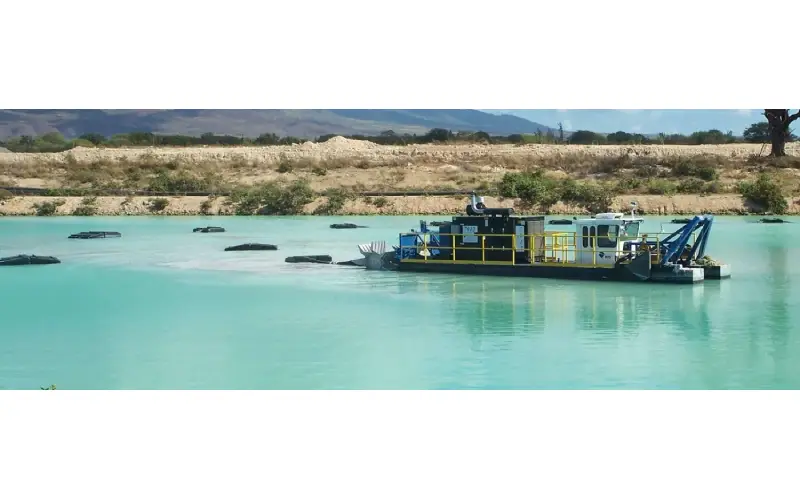Environmental Benefits of Hydraulic Dredge in Marine Ecosystems

Hydraulic dredging is a widely utilized technique for excavation and sediment removal in marine and freshwater environments. This method involves using a powerful hydraulic pump to suck up and transport sediment from the bottom of water bodies, such as rivers, lakes, and seas, through a pipe to a designated disposal or processing site. While traditionally used for navigation maintenance, port construction, and land reclamation, hydraulic dredging has also shown significant potential in positively impacting marine ecosystems. Over the years, this method has evolved with technology, reducing negative environmental consequences and providing an array of ecological benefits. The importance of hydraulic dredge extends far beyond its primary industrial uses, offering advantages such as improving water quality, restoring habitats, controlling pollution, preventing erosion, and supporting biodiversity. These benefits make hydraulic dredging an essential tool in enhancing marine ecosystems, especially in areas affected by human activities and environmental degradation. This article explores how hydraulic dredge works to improve marine ecosystems, emphasizing its contribution to ecological health and long-term sustainability.
How Hydraulic Dredge Improves Water Quality In Marine Ecosystems?
One of the key environmental benefits of hydraulic dredge is its ability to improve water quality in marine ecosystems. Dredging helps to remove excess sediment, organic material, and pollutants from the seabed, significantly enhancing water clarity. When rivers, coastal waters, or harbors accumulate large amounts of sediment or contaminants, the water quality deteriorates, which can lead to reduced oxygen levels, harming aquatic life. By removing these pollutants from the bottom sediments, hydraulic dredging directly impacts the overall water chemistry, restoring a healthier aquatic environment. Additionally, this removal helps prevent the re-suspension of harmful substances into the water column, which may otherwise disrupt the balance of ecosystems. The process can also support nutrient management, as it removes excessive nutrients like nitrogen and phosphorus that can cause harmful algal blooms, eutrophication, and fish kills. In areas with polluted or eutrophic waters, hydraulic dredging becomes a vital tool in mitigating these issues, leading to a noticeable improvement in water quality and fostering a more balanced marine ecosystem.

The Role Of Hydraulic Dredge In Restoring Natural Habitats
Hydraulic dredging plays a crucial role in the restoration of natural habitats within marine ecosystems, particularly in areas that have been severely affected by human development, such as ports, harbors, and industrial zones. Over time, these environments suffer from siltation, accumulation of contaminants, and the destruction of natural flora and fauna due to human activities like construction, shipping, and mining. Hydraulic dredging allows for the restoration of these habitats by removing polluted sediment, debris, and invasive species, enabling the regeneration of native plant and animal life. For instance, the dredging process can open up previously blocked waterways, allowing for improved tidal flow, which is essential for the health of intertidal and subtidal ecosystems. By restoring natural sediment flows, it is possible to encourage the growth of underwater vegetation, such as seagrasses, which provide critical habitats for marine life, including fish, shellfish, and invertebrates. Hydraulic dredge operations also enable the revitalization of coral reefs and mangrove swamps, which are vital for coastal protection and marine biodiversity. The restoration of these habitats not only enhances the health of the ecosystem but also contributes to the recovery of endangered species that depend on these areas for shelter and breeding.
How Hydraulic Dredge Supports Biodiversity In Coastal Areas?
Biodiversity in coastal and marine ecosystems is often under threat from human activities, pollution, and climate change. The use of hydraulic dredge can significantly support biodiversity by improving the quality of these environments. In particular, the removal of harmful sediments, excess nutrients, and pollutants helps to create cleaner, healthier habitats for a diverse range of species. The dredging process can stimulate the recovery of underwater plants like seagrasses and kelp forests, which serve as critical habitats for fish, crustaceans, and other marine organisms. Additionally, hydraulic dredging can help restore mudflats and salt marshes, which provide nesting sites for birds and a food source for various marine life stages, including juvenile fish. Furthermore, by managing sediment movement, hydraulic dredging ensures that species such as coral reefs and mollusks are not buried under thick layers of sediment, which would otherwise inhibit their growth and reproduction. Healthy sedimentary environments contribute to the presence of macroinvertebrates and plankton, which form the basis of marine food webs. By removing excess sediments and pollutants, hydraulic dredging can significantly improve the habitat quality and sustain biodiversity in marine and coastal ecosystems, supporting the survival and reproduction of various species.
Hydraulic Dredge And Its Impact On Sediment Management
Effective sediment management is crucial for maintaining the balance of marine ecosystems. Over time, water bodies can accumulate excessive sediments due to erosion, storm events, or human activities, leading to environmental problems like decreased water quality, loss of habitats, and poor navigation conditions. Hydraulic dredging offers an efficient method of managing sediment by removing the build-up from the bottom of water bodies and transporting it to designated disposal areas. Proper sediment management is vital in preventing the smothering of aquatic plants, fish habitats, and coral reefs, which rely on clean, healthy sediments for their growth and sustainability. Additionally, hydraulic dredging allows for the removal of contaminated sediments that may harbor heavy metals, toxins, and persistent organic pollutants, which could otherwise leach into the water column and cause widespread environmental harm. By regularly removing sediments that could contribute to ecosystem degradation, hydraulic dredging ensures that marine ecosystems remain in a state that supports sustainable biodiversity. Furthermore, the method enables the redistribution of sediments to areas where they can be more beneficial, such as coastal beaches and wetlands, where they can promote shoreline stability and provide nourishment to ecosystems that depend on sediment for their survival.
The Contribution Of Hydraulic Dredge To Pollution Control
Pollution is one of the greatest threats to marine ecosystems, with contaminants such as plastics, oils, heavy metals, and chemicals wreaking havoc on water quality and biodiversity. Hydraulic dredging is an effective method for controlling pollution in marine environments, particularly in heavily industrialized areas where contamination from shipping, agriculture, and wastewater is prevalent. By removing polluted sediment, hydraulic dredging helps to eliminate a primary source of contamination in the water. Contaminants such as heavy metals and persistent organic pollutants (POPs) are often bound to fine particles in the sediment, and when these particles are disturbed, the contaminants can enter the water column, affecting the entire food chain. Dredging helps to capture and remove these harmful substances before they can spread, significantly reducing the levels of pollution in the surrounding environment. In addition to sediment removal, hydraulic dredging can also facilitate the safe disposal or remediation of polluted sediment, further contributing to long-term pollution control efforts. By improving water quality and preventing the re-suspension of toxins, hydraulic dredging supports marine health and protects coastal communities from the adverse effects of pollution, such as the loss of fisheries and the degradation of recreational areas.
How Hydraulic Dredge Aids In Shoreline Erosion Prevention?
Shoreline erosion is a significant issue for many coastal areas, particularly in regions prone to storms, sea-level rise, and human development. The impact of erosion can lead to the loss of valuable land, damage to infrastructure, and destruction of critical habitats for plants and animals. Hydraulic dredging plays a vital role in preventing shoreline erosion by reinforcing coastal areas with sediment. This process involves removing sediment from deeper areas of the water and redistributing it along the shoreline to replenish beaches, dunes, and other vulnerable coastal ecosystems. By providing a sustainable source of sediment, hydraulic dredging can restore eroded areas and prevent further damage from waves and tidal forces. Additionally, by maintaining healthy sedimentation patterns, hydraulic dredging helps to stabilize the shoreline and reduce the impact of future storms or flooding events. Coastal wetlands and marshes, which act as natural buffers against erosion, can also benefit from the redistribution of dredged material, providing added protection to the land. In this way, hydraulic dredging supports both natural and engineered solutions to shoreline erosion, contributing to the long-term resilience of coastal ecosystems and communities.
The Long-Term Environmental Benefits Of Using Hydraulic Dredge
While hydraulic dredging has immediate benefits for improving water quality, restoring habitats, and managing sediments, its long-term impact on marine ecosystems is equally significant. Over time, hydraulic dredging can help restore ecological balance in areas that have been affected by industrial activities, shipping traffic, and urbanization. By continuously removing polluted sediments, hydraulic dredging prevents the accumulation of contaminants and the gradual degradation of marine ecosystems. In addition, the process can foster the recovery of endangered species and habitats, enhancing biodiversity and ensuring that marine environments remain viable for future generations. The long-term benefits of hydraulic dredging also extend to climate resilience, as restored wetlands, seagrass meadows, and mangroves help mitigate the effects of climate change by sequestering carbon, reducing coastal flooding, and enhancing natural carbon sinks. Furthermore, regular maintenance of water bodies through hydraulic dredging helps to preserve navigational channels and supports the sustainable use of marine resources. Overall, hydraulic dredging is a key component of long-term environmental stewardship, contributing to the ongoing health and sustainability of marine ecosystems.
Conclusion
Hydraulic dredging is more than just a tool for maintaining navigational channels or supporting construction projects; it is a crucial method for improving the health of marine ecosystems and addressing some of the most pressing environmental challenges facing coastal areas. From enhancing water quality and managing sediment to supporting biodiversity and mitigating shoreline erosion, the environmental benefits of hydraulic dredging are far-reaching. By removing contaminants, restoring habitats, and ensuring the sustainable management of marine resources, hydraulic dredging contributes to the overall resilience of marine ecosystems.
Resource Link:
https://en.wikipedia.org/wiki/Dredge_valve

Jon Burton, a dedicated advocate for education reform, navigates the landscape of learning with passion and purpose. With a profound belief in the transformative power of education, Jon explores innovative approaches to teaching and learning, seeking to inspire and empower students of all ages. Through his writings, he shares insights into educational theory, curriculum development, and classroom practice, aiming to foster a culture of lifelong learning and intellectual curiosity.





